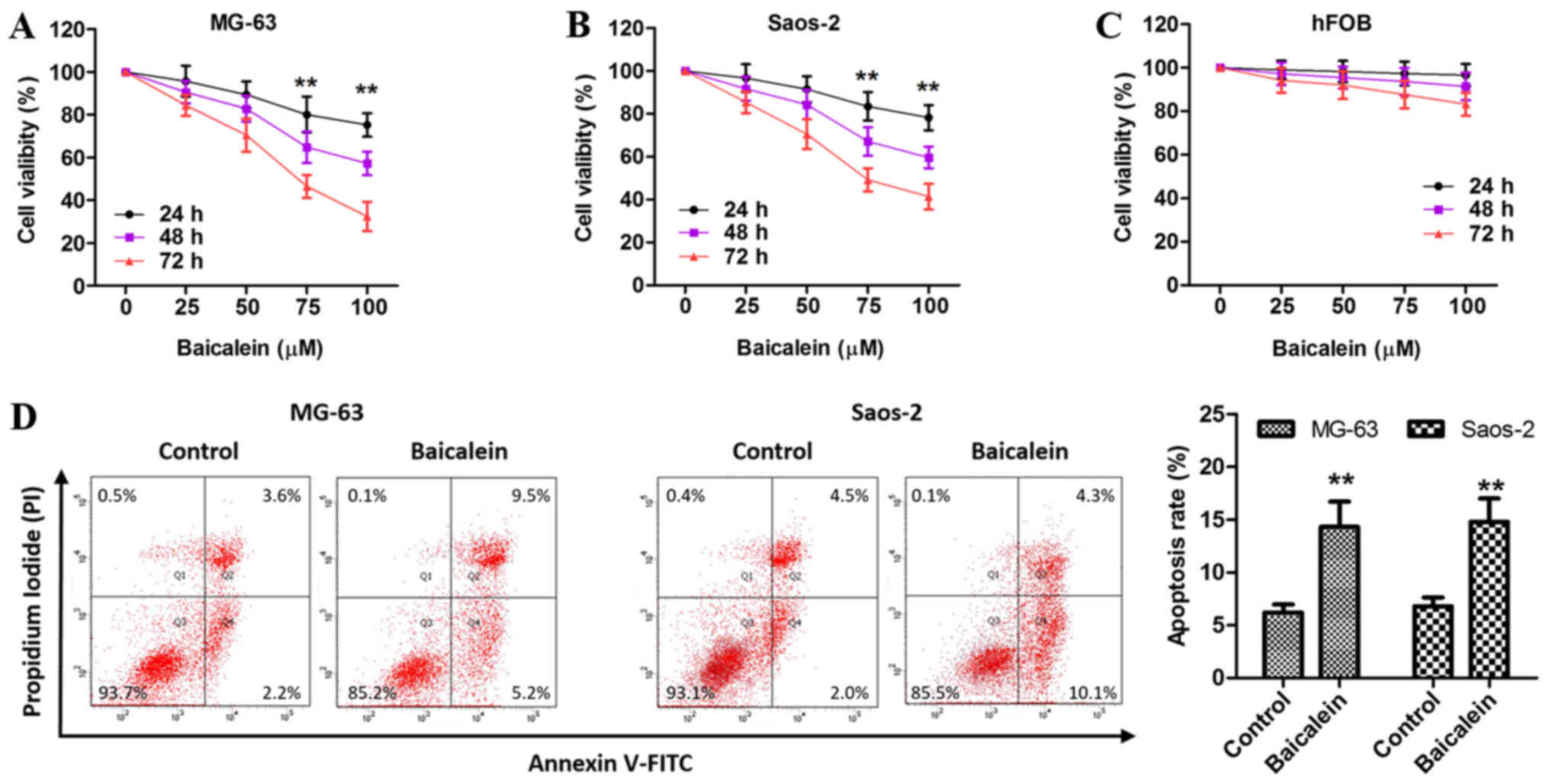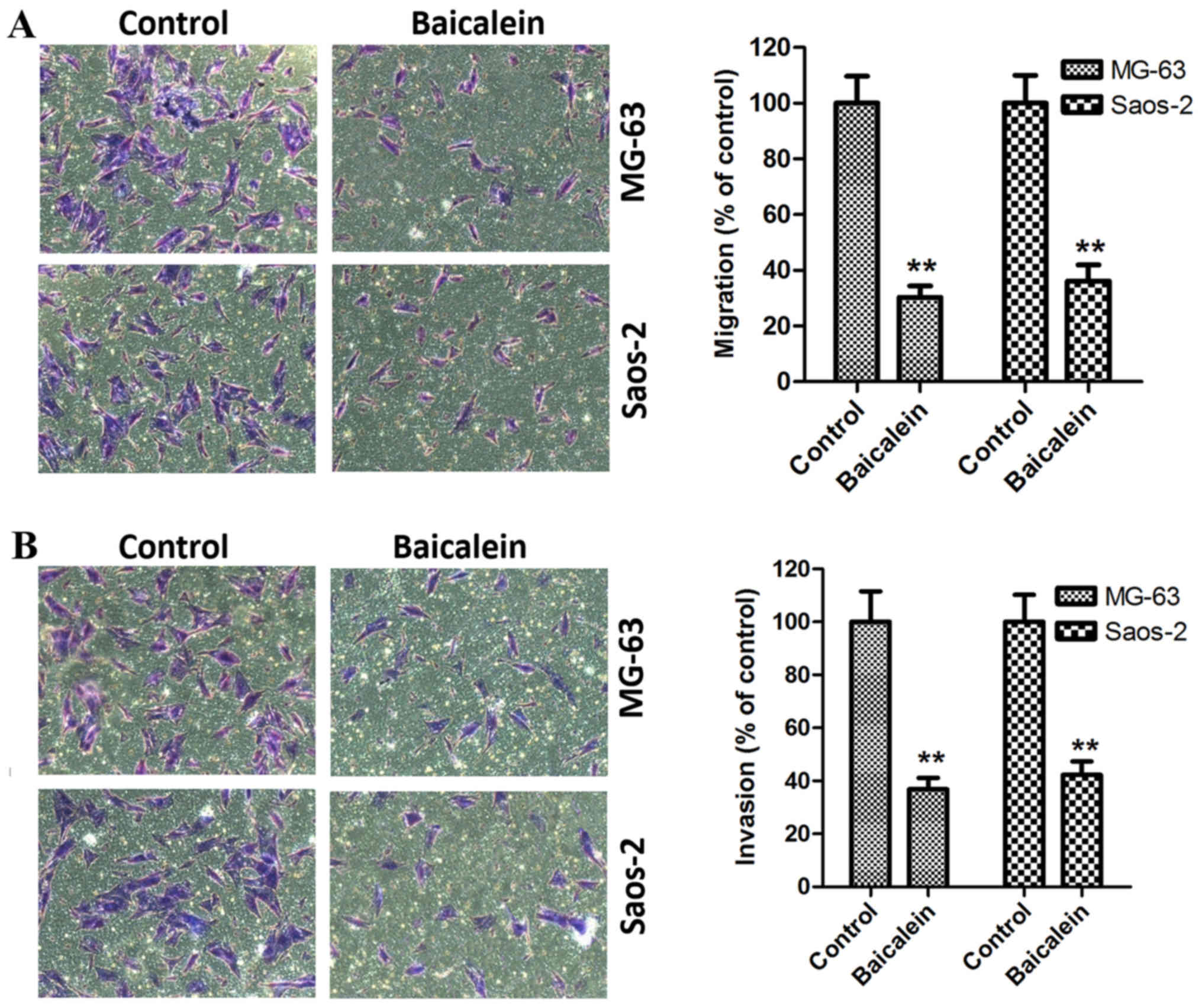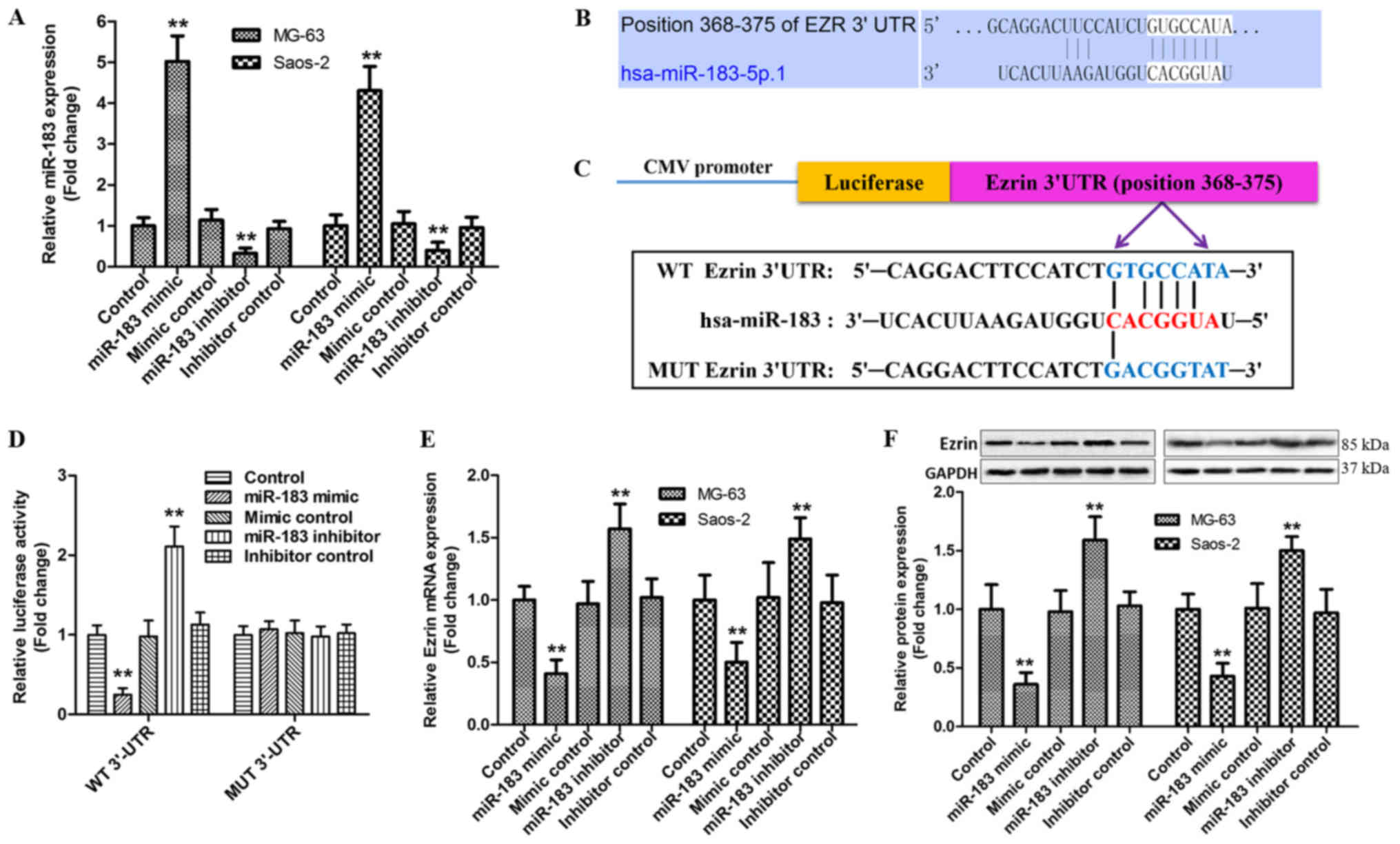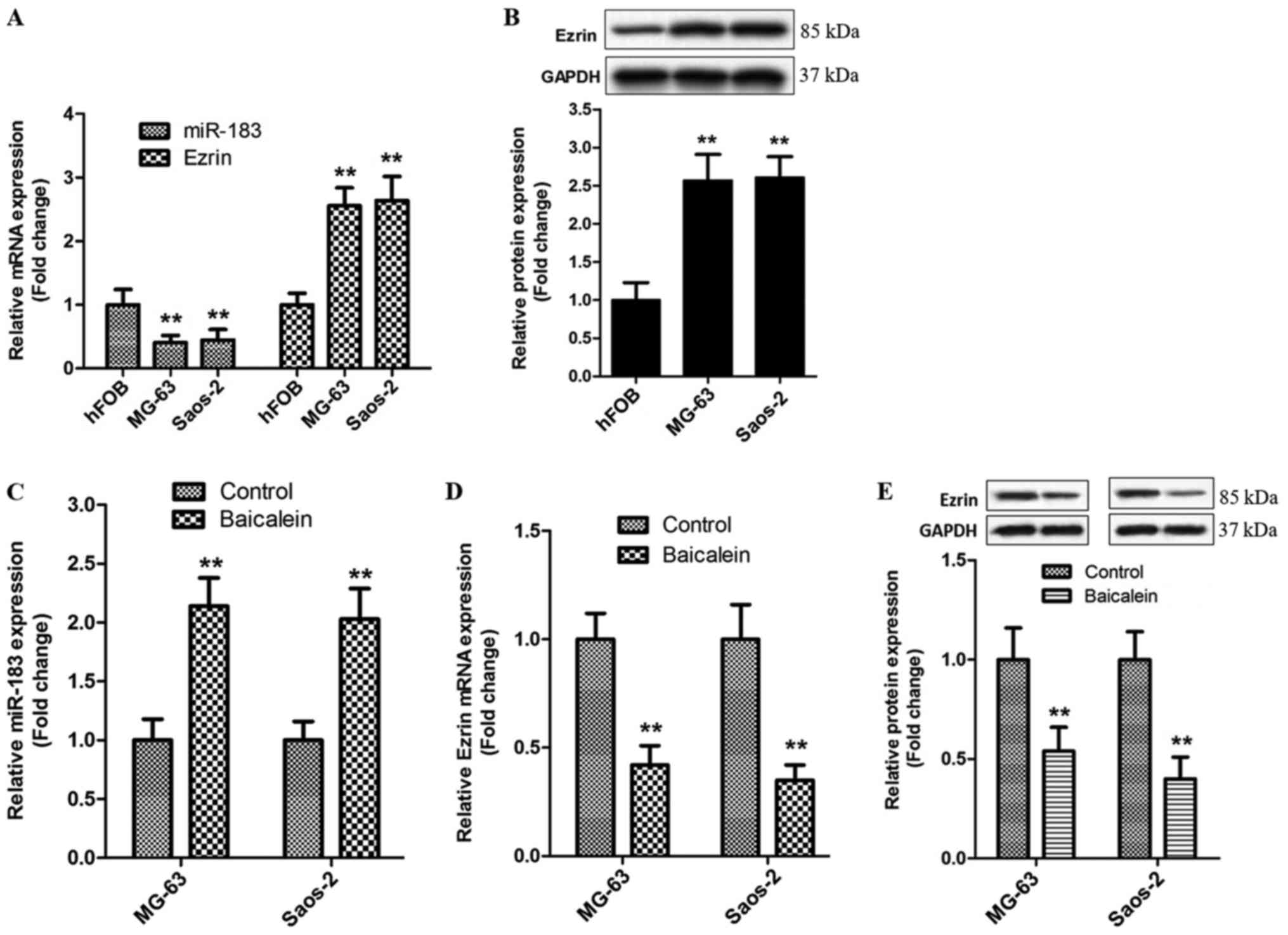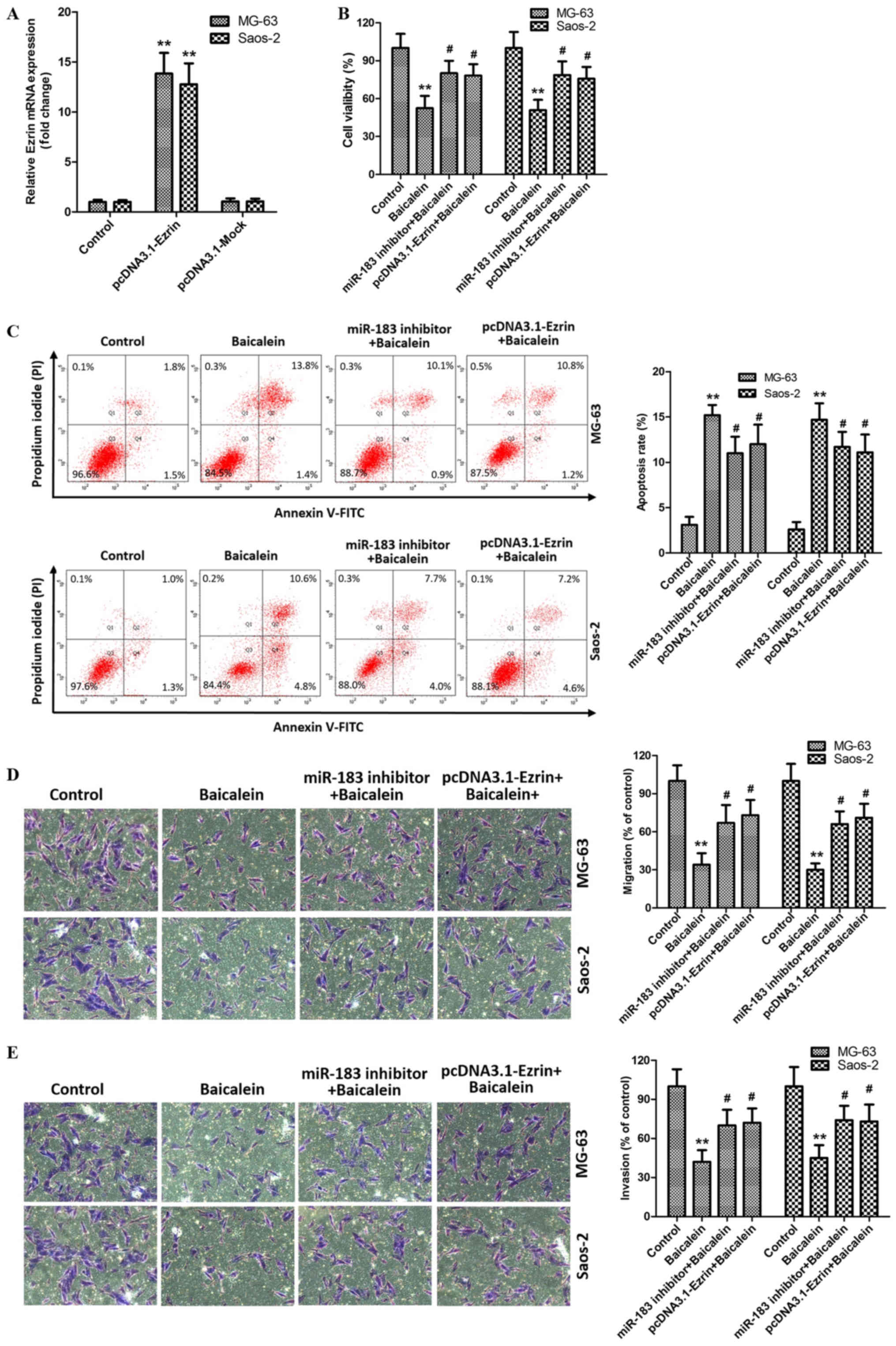Baicalein inhibits osteosarcoma cell proliferation and invasion through the miR‑183/Ezrin pathway
- Authors:
- Published online on: May 17, 2018 https://doi.org/10.3892/mmr.2018.9036
- Pages: 1104-1112
Abstract
Introduction
Osteosarcoma (OS) is regarded as the most common primary malignant bone tumor. It occurs chiefly in children and adolescents who account for ~70% of all cases (1). Like the vast majority of malignant tumors, OS is highly invasive and has distant metastatic potential, especially in the lung (2). Despite surgery in combination with chemotherapy and/or radiotherapy has greatly improved the prognosis of OS patients, five-year survival rate is still lower. Moreover, chemotherapy can lead to drug-resistance and produce life-threatening side effects, such as cardiotoxicity and nephrotoxicity. Thus, there is an urgent need to develop safer and more effective anti-OS drugs.
The biologically active compounds extracted from plants and other natural sources have become an attractive strategy for treating cancers, including OS. Scutellaria baicalensis (SB) Georgi, a traditional Asian herb, is widely applied in the clearance of heat dampness and purgation of fire detoxification (3). Baicalein (5,6,7-trihydroxyflavone), one of the primary active elements of this plant, exerts a variety of pharmacological functions, such as anti-oxidation, anti-proliferation, and apoptosis induction (4,5). There is growing evidence that administration of baicalein inhibits the development of many tumors, including cervical cancer, colorectal cancer, bladder cancer and breast cancer (6–9). Notably, baicalein has also a potent anti-OS effect. However, the potential molecular mechanisms of baicalein on human OS are still vague.
MicroRNAs (miRNAs) are a class of small and non-coding RNA molecules, which can regulate gene expression at the post-transcriptional level by binding to the 3′-untranslated region (UTR) of target mRNAs. Dysregulation of miRNAs is involved in the maligantly biological behaviors of tumors (10,11). As an evolutionarily conserved miRNA, miR-183 has been showed to serve as either a tumor suppressor or oncogene in various human tumors (12). Ezrin gene is located in 6q25 and composed of 585 amino acids and can mediate the tumor invasion and metastasis (13,14). Research has revealed that miR-183 level was dramatically decreased in OS cells and tissues, enhancing the migration and invasion of OS by targeting Ezrin (15). Moreover, our previous study also confirmed that Ezrin aggravated the aggressiveness of OS, and was a direct target of miR-183 (16). Therefore, it could be ascertained that the miR-183/Ezrin pathway plays vital roles in the development and progression of OS. However, there have not yet been any investigations concerning whether the antitumor effects of baicalein on OS were triggered by miR-183/Ezrin pathway until now.
In the present study, we found that baicalein inhibited the proliferation, migration and invasion and induced apoptosis in two human OS cell lines, MG-63 and Saos-2. Importantly, activation of the miR-183/Ezrin pathway was required for these effects. These results provide a novel insight into the mechanisms by which baicalein protects against OS.
Materials and methods
Drugs, reagents and antibodies
Baicalein was obtained from Sigma-Aldrich Chemical Co. (St. Louis, MO, USA). Dulbecco's modified Eagle's medium (DMEM), penicillin/streptomycin, 0.25% trypsin-EDTA, and dimethyl sulphoxide (DMSO) were purchased from Gibco (Grand Island, NY, USA). Anti-Ezrin (1:500) and anti-phosphor-Ezrin (1:500) antibodies were acquired from Abcam (Cambridge, MA, USA). In addition, anti-GAPDH (1:1,000) and secondary antibodies (1:3,000) were obtained from the Cell Signaling Technology (CST; Beverly, MA, USA).
Cell culture
Human OS cell lines MG-63 and Saos-2 were purchased from China Center for Type Culture Collection (Wuhan, China), and human osteoblast cell line hFOB1.19 was obtained from the Chinese Cell Bank of the Chinese Academy of Sciences (Shanghai, China). MG-63 and Saos-2 cells were maintained in complete medium containing DMEM, 10% fetal bovine serum (FBS; Biolnd, Israel), 50 U/ml penicillin/streptomycin in a humidified incubator with 5% CO2 at 37°C. hFOB1.19 cells were cultured in complete medium consisting of DMEM/F12 (1:1) medium, 10% FBS (Biolnd, Israel), and G418 (0.3 mg/ml) with 5% CO2 at 34°C. Sebsequently, these cells were digested by 0.25% trypsin-EDTA solution for all in vitro experiments and for cell pass and 27age unless stated otherwise after cells reached at least 80% confluence.
Cell proliferation assay
Baicalein was dissolved in DMSO solution to a final concentration of 4 mM. MG-63, Saos-2 and hFOB cells were seeded at density 5,000 cells/well in 96-well plates and cultured for 24 h. Cells were treated with baicalein at different concentrations (0, 25, 50, 75 and 100 µM) at 0 h, and then were cultured for 24, 48 or 72 h. Subsequently, the proliferation assay was performed using a Cell Counting kit-8 (CCK-8; Dojindo Molecular Technologies, Inc., Kumamoto, Japan) according to the manufacturer's instructions. A microplate reader (Thermolex Molecular Device Co.) was utilized to detect the absorbance at 450 nm.
Cell apoptosis analysis
Following maintenance in culture by different treatments, cell apoptosis was assessed using an Annexin V/fluorescein isothiocyanate (FITC) Apoptosis Detection kit I (BD Biosciences, San Jose, CA, USA). The untreated or treated MG-63 and Saos-2 cells were harvested after indicated treatments with 0.25% trypsin-EDTA, and a single cell suspension was prepared. Cells were washed twice with cold PBS, centrifugated at 1,500 rpm for 5 min and resuspended in 1X Binding Buffer so that cell density reached 1×106 cells/ml. 5 µl Annexin V/FITC was added to 300 µl the above resuspended solution and incubated for 10 min, followed by adding 5 µl propidium iodide (PI) for a 10 min incubation at room temperature in the dark. Cell apoptosis were then detected using flow cytometry (BD Biosciences). The results were analyzed by cell quest software (BD Biosciences) to determine the rate of apoptosis in the lower right quadrant.
Cell invasion and migration assay
Cell invasion assay was carried out using Millicell Hanging Cell Culture Insert (24-well, pore size 5 µm; Merck Millipore, Billerica, MA, USA). After treatment, MG-63 and Saos-2 cells resuspended to a density of 5×104 cells/ml in serum-free DMEM medium were transferred into upper chamber of the inserts coated with 30 mg/cm2 of Matrigel (BD Biosciences), DMEM medium with 20% FBS were added to the well out of the insert and then incubation for different concentration or time based on experimental program. Ultimately, cells on the upper membrane surface were removed through careful wiped off a cotton swab, and the cells on lower surface were fixed with 95% ethanol for 30 min and stained with 0.2% Crystal Violet solution for 30 min. Five vision fields per chamber were randomly selected and then counted the number of invasion cells under an inverted microscope. The general procedure of the migration assay was performed the same as that of the invasion assay described above, except that Matrigel was not applied.
RNA extraction and reverse transcription-quantitative polymerase chain reaction (RT-qPCR) analysis
Total RNAs were extracted from either MG-63 or Saos-2 cells using TRIzol reagent (Invitrogen; Thermo Fisher Scientific, Inc., Waltham, MA, USA) according to the manufacturers' protocol. The purity and concentration of RNAs were detected by a NanoDrop ND-1,000 spectrophotometer (Thermo Fisher Scientific, Inc., Wilmington, DE, USA). The reverse transcription reactions were conducted by a miRcute miRNA Reverse Transcription kit (TianGen Biotech Co., Ltd., Beijing, China) and PrimeScript RT Master Mix (Perfect Real Time; Takara Biotechnology Co., Ltd., Dalian, China). All reactions were performed using a 7500 Real-Time PCR System (Thermo Fisher Scientific, Inc.) in a reaction volume of 20 µl. The levels of miR-183 and Ezrin were normalized to U6 small nuclear RNA and GAPDH, respectively. The relative quantification was calculated by applying the 2−∆∆Cq method (17). The PCR primers were designed and synthesized by Shanghai Sangon Biological Engineering Technology Co., Ltd., (Shanghai, China) (Table I).
Western blot analysis
Total proteins were extracted from MG-63 or Saos-2 cells using RIPA Lysis Buffer (Beyotime, Shanghai, China). The protein concentrations were measured via Enhanced BCA Protein Assay kit (Bio-Rad, Richmond, CA, USA). Lysates of Total protein were separated by a 10% sodium dodecyl sulfate-polyacrylamide (SDS-PAGE) gel and transferred to a polyvinylidene fluoride (PVDF) membrane (Merck Millipore). The membrane was blocked by 5% (v/v) skim milk in Tris-buffered saline Tween-20 (TBST) at room temperature for 2 h, followed by incubation with the primary antibodies at 4°C overnight. After washing, the membrane was incubated with HRP-conjugated secondary antibody at room temperature for 1 h. The proteins were visualized using a chemiluminescence method (electrochemiluminescence and western blot detection system; Amersham Biosciences, Foster City, CA, USA). The results were normalized using GAPDH.
Cell transfection
MiR-183 mimics/negative controls and inhibitors/negative controls were supplied by RiboBio (Guangzhou, China). The whole DNA fragment of Ezrin was amplified from the OS cells. The obtained products were cloned into recombinant plasmid pcDNA3.1(+)-EGFP to overexpress Ezrin (pcDNA3.1-Ezrin; Invitrogen; Thermo Fisher Scientific, Inc.), with the empty vector as a negative control (pcDNA3.1-Mock). The constructs were identified by DNA sequencing. Both MG-63 and Saos-2 cells were seeded into a 12-well plate at a 1×105/ml density, and then transfected with 20 nM miR-183 mimic/negative controls or 40 nM miR-183 inhibitors/negative controls or pcDNA3.1-Ezrin using Lipofectamine 2000 (Invitrogen; Thermo Fisher Scientific, Inc.) according to the manufacturer's instructions.
Dual luciferase reporter assay
A fragment of 3′UTR of Ezrin containing the putative miR-183 binding site was amplified by RT-PCR. The amplified product was then subcloned into a pMIR-REPORT luciferase reporter vector applying restriction sites XhoI (Promega, Madison, WI, USA). The mutated sequences of predicred miR-183 binding located in the 3′UTR of Ezrin mRNA were introduced using the QuikChange kit (Stratagene, La Jolla, CA, USA). All plasmid constructs were verified by DNA sequencing (Biology Engineering Corp., Shanghai, China). Successively, the 20 nM miR-183 mimics/negative controls or 40 nM miR-183 inhibitor/negative controls and 0.1 µg pMIR-REPORT-Ezrin (WT) or pMIR-REPORT-Ezrin (MUT) constructs were co-transfected into the cells using Lipofectamine 2000. After transfection for 48 h, the Dual-Luciferase Reporter Assay System (Promega) was used to detect the luciferase activity. The Renilla luciferase values were regarded as a correction factor, and the firefly/Renilla ratio was obtained. Luciferase activity was averaged from three replicates for each transfection.
Statistical analysis
All data were presented as the means ± standard deviation (SD), and all of graphs were produced by GraphPad Prism 5.0 Software (Graph Pad Software, Inc., La Jolla, CA, USA). SPSS 22.0 software (IBM Corp., Armonk, NY, USA) was used for all statistical analyses. Results were analyzed using Student's t-test for comparison between two groups or one-way ANOVA followed by the Tukey's test for comparison of multiple groups. P<0.05 was considered to indicate a statistically significant difference.
Results
Baicalein inhibits proliferation and promotes apoptosis in MG-63 and Saos-2 cells
To investigate the effect of baicalein on OS cell proliferation, cells were treated with various concentrations of baicalein for the indicated time, followed by the CCK-8 assay. Our results showed that baicalein inhibited the proliferation of MG-63 and Saos-2 cells in a concentration- and time-dependent manner (Fig. 1A and B), but did not affect hFOB cell growth (Fig. 1C). Given that 100 µM baicalein had the optimal efficacy, we selected this dose for subsequent experiments.
Given the fact that the inhibition of apoptosis contributed to cell proliferation in various type of tumor cells, next we employed fluorescence activated cell sorter (FACS) analysis via Annexin V-FITC and PI double-staining to evaluate the apoptosis rate of MG-63 and Saos-2 cells exposed to 100 µM baicalein for 48 h. As shown in Fig. 1D, the apoptosis rate of MG-63 and Saos-2 cells was low in control group but significantly elevated in baicalein-treated group, suggesting an inductive effect of baicalein on MG-63 and Saos-2 cell apoptosis.
Baicalein represses the migration and invasion of OS cells
It is well known that migration and invasion are the two pivotal stages in malignant progression and metastasis for tumors. Thus, the present study further evaluated the effects of baicalein on the aggressive potential of MG-63 and Saos-2 cells using cell migration and invasion assays. After stimulation of MG-63 and Saos-2 cells with 100 µM baicalein for 48 h, the migration ability of cells was measured. In Fig. 2A, we found that the migration ability of MG-63 and Saos-2 cells was obviously inhibited. Aside from migration test, we also employed the cell invasion assay to measure the invasion ability of MG-63 and Saos-2 cells. As shown in Fig. 2B, the similar effect on invasive ability was also observed in parallel invasive test, compared with the control group. Altogether, the above results reveal that baicalein can suppress the migration and invasion ability of MG-63 and Saos-2 cells.
Identification of Ezrin as a direct target of miR-183
It has been reported that miRNAs are important regulators in the aggressive behavior of tumor, including OS (18). Our previous study has been proposed that Ezrin as a direct target of miR-183 promotes the migration and invasion of OS MG-63 cells through increased N-cadherin and activating ERK signaling (16). However, whether baicalein regulates the activation of miR-183/Ezrin pathway in MG-63 and Saos-2 cells remains unclear. In order to explore this hypothesis, we validated again the relationship between Ezrin and miR-183 in the current research. Treatment of MG-63 and Saos-2 cells with miR-183 mimic/negative control or miR-183 inhibitors/negative control both exerted a higher transfection efficiency (Fig. 3A). The pairing site of Ezrin 3′-UTR with miR-183 were predicted by TargetScan (an open sourced software) (Fig. 3B). A luciferase reporter gene with 3′-UTR of Ezrin downstream (WT-Ezrin), its mutant version (MUT-Ezrin) via the binding site mutagenesis were also constructed (Fig. 3C). As shown in Fig. 3D, the luciferase activity of cells transfected with miR-183 mimic was dramatically decreased in wild type, but not mutant. Furthermore, the RT-qPCR and western blot analyses showed that overexpression of miR-183 noteworthily reduced the levels of Ezrin mRNA and protein compared with control group, whereas an opposite effect appeared in response to miR-183 inhibitor (Fig. 3E and F). Overall, these results demonstrate that miR-183 directly targets the 3′-UTR of Ezrin and negatively regulates its expression.
Baicalein increases miR-183 levels and represses Ezrin expression in OS cells
We firstly detected the contents of miR-183 and Ezrin in MG-63, Saos-2 and hFOB cells, respectively. RT-qPCR showed that miR-183 levels in MG-63 and Saos-2 cells were lower than those in hFOB cells (Fig. 4A). However, the expression of Ezrin mRNA and protein displayed an opposed tendency in above cells (Fig. 4A and B). These data indicate that abnormal expressions of miR-183 and Ezrin might be correlated highly with the pathogenesis and metastasis of OS.
Next, the underlying effects of baicalein on miR-183/Ezrin pathway were investigated using RT-qPCR and western blot in MG-63 and Saos-2 cells treated by 100 µM baicalein for 48 h. As demonstrated in Fig. 4C, baicalein-stimulated MG-63 and Saos-2 cells displayed a significant increase in miR-183 level in comparison with control group. However, the alterations in the mRNA and protein levels of Ezrin presented an opposite tendency in above parallel groups (Fig. 4D and E). In conclusion, these data corroborate that stimulation of baicalein is able to promote the generation of miR-183 and then retard the expression of Ezrin in MG-63 and Saos-2 cells.
miR-183/Ezrin pathway is required for the effects of baicalein on OS cells
As evidenced above experiments, baicalein represses the proliferation and migration and invision abilitiess, and participates in the activation of apoptosis in MG-63 and Saos-2 cells. Meanwhile, it as well negatively regulates the Ezrin expression via upregulating miR-183 level in MG-63 and Saos-2 cells. Therefore, we hypothesized that the miR-183/Ezrin pathway might be responsible for the antitumor effects of baicalein on OS cells. To verify the assumption, MG-63 and Saos-2 cells were co-cultured with baicalein and miR-183 inhibitors or pcDNA3.1-Ezrin, which showed a higher transfection efficiency (Fig. 5A). As expected, miR-183 inhibitor significantly reversed baicalein-induced high apoptosis rate and low proliferation, migration and invasive ability in MG-63 and Saos-2 cells, compared with baicalein group (Fig. 5B-E). Besides, we also found that overexpression of Ezrin by pcDNA3.1-Ezrin exerts similary effect in stumilation of baicalein with MG-63 and Saos-2 cells (Fig. 5B-E). Taken together, these observations indicate that baicalein induces apoptosis and attenuates proliferation and migration and invasion abilities of MG-63 and Saos-2 cells via activating miR-183/Ezrin pathway.
Discussion
OS is originated from mesenchymal stem cells producing osteoid or immature bone, and mainly characterized by high aggressiveness and metastasis. Multi-drug chemotherapy approaches for OS patients have obviously improved the survival rate subsequent to surgical resection (19). However, it is undesirable to the drug-resistance and life-threatening side effects induced by chemotherapy, leading to treatment failure or shorter survival. Thus, there is an urgent need for newer effective and low-toxic agents for patients with OS, especially for patients suffered from metastatic disease or disease recurrence. Enhancing the understanding of basic biology of therapeutic agents to OS has been a high priority in recent years.
Baicalein, a bioactive flavone purified from SB, is widely used in nutraceuticals and pharmaceuticals. It has been shown that baicalein has considerable potential in the treatment and prevention of cancers by inducing apoptosis, inhibiting the colony formation, migration and invasion (3,20). Moreover, baicalein only suppresses the growth of cancer cells without the effects on normal cells (21,22). In addition, researches have shown that baicalein can inhibit the progression of OS cells by a variety of biological pathways. Baicalein suppresses progression of OS cells via inactivating the Wnt/β-catenin signaling pathway (23). Zhang and his colleagues reported that baicalein inhibitors reduces the viability of MG-63 cells by repressing c-MYC expression through the Wnt signaling pathway (24). Baicalein induces MG-63 cells apoptosis via ROS-induced BNIP3 expression (25). In the present study, we found that baicalein markedly promoted apoptosis and inhibited cell proliferation, migration and invasion of MG-63 and Saos-2 cells, but not hFOB cells. Taken together, these studies suggest that baicalein may be a promising and potential candidate for chemotherapeutic agents to treat OS. However, the precision mechanism by which baicalein mediates the development and progression of OS cells remains unclear.
Ectopic expression of miRNAs has been shown to be implicated in regulating proliferation, apoptosis, migration and invasion in multifarious cancer cells, including OS cells (26–28). These small molecules have emerged as potential targets for the diagnosis, therapy and prognosis of OS. MiR-183 has been identified as a promising biomarker, which was attributed to its early cancer detection and exact prognosis as well as high-efficiency treatment (29). Previous reports have shown that downexpression of miR-183 was observed in OS tissues or various cell lines (15,30,31). Similarly, our previous research and this current study also revealed a similar tendency for miR-183 expression in OS MG-63 and Saos-2 cells (16). These data suggest that downregulation of miR-183 plays a pivotal role in promoting aggressiveness of OS.
It is generally known that the effect of miRNAs on the target gene is achieved by binding to the 3′-UTR of target gene. Ezrin, a target gene of miR-183, is a widely explored oncogene in various cancers, and as well involved in the tumorgenesis of OS. Our previous data and present research have demonstrated that Ezrin expression was markedly increased in MG-63 and Saos-2 cells, promoting invasion and migration of cells; by contrast, these effects were abolished by knockdown of Ezrin (16). Furthermore, positive Ezrin expression is closely correlated with clinical grade, free-metastasis or metastasis, and adverse prognosis of patients with OS (32,33). Thereby, Ezrin may serve as a contributor for the invasiveness and carcinogenesis of OS.
Increasing evidence has illustrated that the miR-183/Ezrin pathway is involved in the progression of OS. It has been shown that downexpression of miR-183 promotes migration and invasion of OS by targeting Ezrin (15). MiR-183 inhibits the metastasis of OS via downregulation of Ezrin expression in F5M2 cells (31). Interestingly, research has shown that the aberrant expression of miR-183/Ezrin axis may be related to the prediction of aggressiveness and poor prognosis for patients with OS (30). In the current study, we validated that Ezrin was a target gene of miR-183, suggesting that miR-183 negatively regulated Ezrin expression. Given the roles of baicalein or miR-183/Ezrin pathway in OS, we rationally hypothesize that the antitumor effects of baicalein on OS were presented by activating the miR-183/Ezrin pathway. In this study, we found that baicalein significantly increased the miR-183 levels and decreased Ezrin expression in human OS MG-63 and Saos-2 cells. In addition, our findings showed that transfection of miR-183 inhibitor or overexpression of Ezrin abolished baicalein-induced antitumor effects in MG-63 and Saos-2 cells. Thus, the miR-183/Ezrin pathway is involved in the suppressive effects of baicalein on MG-63 and Saos-2 cells.
In summary, our study clearly demonstrates that baicalein enhances apoptosis and inhibits cell proliferation, migration and invasion by activation of miR-183/Ezrin pathway in human OS MG-63 and Saos-2 cells. These findings reveal a molecular mechanism by which baicalein inhibits progression of OS, providing in vitro evidence to support baicalein as an efficient agent for the treatment of OS.
Acknowledgements
The authors would like to thank all of the volunteers who took part in this study.
Funding
Financial support of this study was obtained from the Natural Science Foundation in Hunan Province, China (grant no. 2015JJ4043), the Key Project of Health and Family Planning Commission in Hunan Province (grant no. A2017016), Clinical Research Center For Spinal Minimally Invasive Techniques in Hunan Province (grant no. 2017SK4004) and the Key Research and Development Plan in Hunan Province (grant no. 2017SK2104).
Availability of data and materials
The datasets used and/or analyzed during the current study are available from the corresponding author on reasonable request.
Authors' contributions
JZ performed the molecular experiments and drafted the manuscript. WY, Y-BZ, Y-XX, L-SW and W-KH performed the statistical analysis. W-JW conceived and designed the current study and revised the manuscript. All authors read and approved the final manuscript.
Ethics approval and consent to participate
Not applicable.
Consent for publication
Not applicable.
Competing interests
The authors declare that they have no competing interests.
Glossary
Abbreviations
Abbreviations:
|
OS |
Osteosarcoma |
|
SB |
Scutellaria baicalensis |
|
miRNAs |
microRNAs |
|
3′-UTR |
3′-untranslated region |
References
|
Li J, Yang Z, Li Y, Xia J, Li D, Li H, Ren M, Liao Y, Yu S, Chen Y, et al: Cell apoptosis, autophagy and necroptosis in osteosarcoma treatment. Oncotarget. 7:44763–44778. 2016.PubMed/NCBI | |
|
Zhang J, Yan YG, Wang C, Zhang SJ, Yu XH and Wang WJ: MicroRNAs in osteosarcoma. Clin Chim Acta. 444:9–17. 2015. View Article : Google Scholar : PubMed/NCBI | |
|
Zhou RT, He M, Yu Z, Liang Y, Nie Y, Tai S and Teng CB: Baicalein inhibits pancreatic cancer cell proliferation and invasion via suppression of NEDD9 expression and its downstream Akt and ERK signaling pathways. Oncotarget. 8:56351–56363. 2017.PubMed/NCBI | |
|
Liu X and Liu S, Chen J, He L, Meng X and Liu S: Baicalein suppresses the proliferation of acute T-lymphoblastic leukemia Jurkat cells by inhibiting the Wnt/β-catenin signaling. Ann Hematol. 95:1787–1793. 2016. View Article : Google Scholar : PubMed/NCBI | |
|
Wei N, Wei Y, Li B and Pang L: Baicalein promotes neuronal and behavioral recovery after intracerebral hemorrhage via suppressing apoptosis, Oxidative stress and neuroinflammation. Neurochem Res. 42:1345–1353. 2017. View Article : Google Scholar : PubMed/NCBI | |
|
Ye H, Zhang Y, Wang Y, Xia J, Mao X and Yu X: The restraining effect of baicalein and U0126 on human cervical cancer cell line HeLa. Mol Med Rep. 16:957–963. 2017. View Article : Google Scholar : PubMed/NCBI | |
|
Chai Y, Xu J and Yan B: The anti-metastatic effect of baicalein on colorectal cancer. Oncol Rep. 37:2317–2323. 2017. View Article : Google Scholar : PubMed/NCBI | |
|
Choi EO, Park C, Hwang HJ, Hong SH, Kim GY, Cho EJ, Kim WJ and Choi YH: Baicalein induces apoptosis via ROS-dependent activation of caspases in human bladder cancer 5637 cells. Int J Oncol. 49:1009–1018. 2016. View Article : Google Scholar : PubMed/NCBI | |
|
Ma X, Yan W, Dai Z, Gao X, Ma Y, Xu Q, Jiang J and Zhang S: Baicalein suppresses metastasis of breast cancer cells by inhibiting EMT via downregulation of SATB1 and Wnt/β-catenin pathway. Drug Des Devel Ther. 10:1419–1441. 2016. View Article : Google Scholar : PubMed/NCBI | |
|
Palmini G, Marini F and Brandi ML: What is new in the miRNA world regarding osteosarcoma and chondrosarcoma? Molecules. 22:pii: E417. 2017. View Article : Google Scholar : PubMed/NCBI | |
|
Zoni E and van der Pluijm G: The role of microRNAs in bone metastasis. J Bone Oncol. 5:104–108. 2016. View Article : Google Scholar : PubMed/NCBI | |
|
Cao LL, Xie JW, Lin Y, Zheng CH, Li P, Wang JB, Lin JX, Lu J, Chen QY and Huang CM: miR-183 inhibits invasion of gastric cancer by targeting Ezrin. Int J Clin Exp Pathol. 7:5582–5594. 2014.PubMed/NCBI | |
|
Li M, Feng YM and Fang SQ: Overexpression of ezrin and galectin-3 as predictors of poor prognosis of cervical cancer. Braz J Med Biol Res. 50:e53562017. View Article : Google Scholar : PubMed/NCBI | |
|
Kong J, Li Y, Liu S, Jin H, Shang Y, Quan C, Li Y and Lin Z: High expression of ezrin predicts poor prognosis in uterine cervical cancer. BMC Cancer. 13:5202013. View Article : Google Scholar : PubMed/NCBI | |
|
Zhu J, Feng Y, Ke Z, Yang Z, Zhou J, Huang X and Wang L: Down-regulation of miR-183 promotes migration and invasion of osteosarcoma by targeting Ezrin. Am J Pathol. 180:2440–2451. 2012. View Article : Google Scholar : PubMed/NCBI | |
|
Zhang J, Zuo J, Lei M, Wu S, Zang X and Zhang C: Ezrin promotes invasion and migration of the MG63 osteosarcoma cell. Chin Med J (Engl). 127:1954–1959. 2014.PubMed/NCBI | |
|
Livak KJ and Schmittgen TD: Analysis of relative gene expression data using real-time quantitative PCR and the 2(-Delta Delta C(T)) method. Methods. 25:402–408. 2001. View Article : Google Scholar : PubMed/NCBI | |
|
Kushlinskii NE, Fridman MV and Braga EA: Molecular mechanisms and microRNAs in osteosarcoma pathogenesis. Biochemistry (Mosc). 81:315–328. 2016. View Article : Google Scholar : PubMed/NCBI | |
|
Anderson ME: Update on survival in osteosarcoma. Orthop Clin North Am. 47:283–292. 2016. View Article : Google Scholar : PubMed/NCBI | |
|
Gao Y, Snyder SA, Smith JN and Chen YC: Anticancer properties of baicalein: A review. Med Chem Res. 25:1515–1523. 2016. View Article : Google Scholar : PubMed/NCBI | |
|
Dinda B, Dinda S, DasSharma S, Banik R, Chakraborty A and Dinda M: Therapeutic potentials of baicalin and its aglycone, baicalein against inflammatory disorders. Eur J Med Chem. 131:68–80. 2017. View Article : Google Scholar : PubMed/NCBI | |
|
Chung H, Choi HS, Seo EK, Kang DH and Oh ES: Baicalin and baicalein inhibit transforming growth factor-β1-mediated epithelial-mesenchymal transition in human breast epithelial cells. Biochem Biophys Res Commun. 458:707–713. 2015. View Article : Google Scholar : PubMed/NCBI | |
|
Dai G, Zheng D, Wang Q, Yang J, Liu G, Song Q, Sun X, Tao C, Hu Q, Gao T, et al: Baicalein inhibits progression of osteosarcoma cells through inactivation of the Wnt/β-catenin signaling pathway. Oncotarget. 8:86098–86116. 2017. View Article : Google Scholar : PubMed/NCBI | |
|
He N and Zhang Z: Baicalein suppresses the viability of MG-63 osteosarcoma cells through inhibiting c-MYC expression via Wnt signaling pathway. Mol Cell Biochem. 405:187–196. 2015. View Article : Google Scholar : PubMed/NCBI | |
|
Ye F, Wang H, Zhang L, Zou Y, Han H and Huang J: Baicalein induces human osteosarcoma cell line MG-63 apoptosis via ROS-induced BNIP3 expression. Tumour Biol. 36:4731–4740. 2015. View Article : Google Scholar : PubMed/NCBI | |
|
Pal MK, Jaiswar SP, Dwivedi VN, Tripathi AK, Dwivedi A and Sankhwar P: MicroRNA: A new and promising potential biomarker for diagnosis and prognosis of ovarian cancer. Cancer Biol Med. 12:328–341. 2015.PubMed/NCBI | |
|
Taylor MA and Schiemann WP: Therapeutic opportunities for targeting microRNAs in cancer. Mol Cell Ther. 2:1–13. 2014. View Article : Google Scholar : PubMed/NCBI | |
|
Nugent M: microRNA and bone cancer. Adv Exp Med Biol. 889:201–230. 2015. View Article : Google Scholar : PubMed/NCBI | |
|
Zhang QH, Sun HM, Zheng RZ, Li YC, Zhang Q, Cheng P, Tang ZH and Huang F: Meta-analysis of microRNA-183 family expression in human cancer studies comparing cancer tissues with noncancerous tissues. Gene. 527:26–32. 2013. View Article : Google Scholar : PubMed/NCBI | |
|
Mu Y, Zhang H, Che L and Li K: Clinical significance of microRNA-183/Ezrin axis in judging the prognosis of patients with osteosarcoma. Med Oncol. 31:8212014. View Article : Google Scholar : PubMed/NCBI | |
|
Zhao H, Guo M, Zhao G, Ma Q, Ma B, Qiu X and Fan Q: miR-183 inhibits the metastasis of osteosarcoma via downregulation of the expression of Ezrin in F5M2 cells. Int J Mol Med. 30:1013–1020. 2012. View Article : Google Scholar : PubMed/NCBI | |
|
Abdou AG, Kandil M, Asaad NY, Dawoud MM, Shahin AA and Eldayem Abd AF: The prognostic role of Ezrin and HER2/neu expression in osteosarcoma. Appl Immunohistochem Mol Morphol. 24:355–363. 2016. View Article : Google Scholar : PubMed/NCBI | |
|
Zhao DH, Zhu J, Wang WB, Dong F, Zhang Q, Fan HW, Zhang JZ and Wang YM: Correlations of ezrin expression with pathological characteristics and prognosis of osteosarcoma: A meta-analysis. ScientificWorldJournal. 2014:8375432014. View Article : Google Scholar : PubMed/NCBI |



